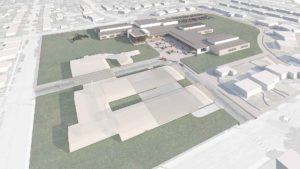If voters in Williston Public School District No. 1 approve a new school, it will likely house kindergarten through fifth grade, reversing course from the plan that created Bakken Elementary.
That school, which opened last year in the district’s old high school building, is adjacent to Williston Middle School and houses fifth and sixth graders.
Ted Rozeboom, a consultant with JLG Architects, told the school board that the decision about whether to keep fifth graders with other middle schoolers or move them back with other elementary students would help determine what the district should build. Districts do both, but most keep kindergarten through fifth grade together, then have schools for sixth through eighth graders and high schoolers, he said.
Keeping fifth through eighth graders in the Bakken Elementary/Williston Middle School complex would mean the district would probably need to build both an elementary and a middle school, he said, and that would mean acquiring land.
Moving fifth graders back with other elementary students would allow more enrollment growth at the middle school level and mean building only an elementary school.
The idea to combine fifth and sixth grades at Bakken Elementary came about because there was overcrowding at both the elementary and high school levels when the district was building the new high school, Rozeboom said. Moving fifth-graders out of elementary schools gave the district breathing room.
The board was generally supportive of moving fifth-graders back with the rest of the elementary grades. The final plan is going to depend heavily on whether voters approve a bond issue for a new school, board member Brion Norby said.
“We can decide if the vote passes that’s how we’re going to go,” he said. “However, if the vote fails, we’re right where we’re at now.”
The timeline JLG has proposed includes public information sessions in late November and a vote on the issue in early 2018.
The district is at or over space capacity at essentially every level, according to Dan Miller from JLG.
At the elementary, middle school and high school levels, the district is using all available classroom space and has started using portable classrooms again.
Not counting portables, the ideal number of students at the elementary level is about 850 and the maximum — that’s calculated as 25 students per class — is 965, Miller said. Right now there are 1,578 elementary students enrolled.
“Even if you were to stay with your portables, you’re still needing to look at space issues,” he said.
Even the new high school, which opened in August 2016 and was built to accommodate 1,200 students, has 1,211 enrolled. The building was planned with the ability to expand and accommodate up to 1,600 students, Miller said.
Rozeboom told the board that the relatively small size of the district’s elementary schools meant that simply adding more portables wouldn’t be enough of a solution. And he cautioned against investing too much in older buildings that might need to be replaced soon anyway.
“Doing nothing is still going to cost you a whole bunch of money,” he said.
JLG is planning another presentation at the November school board meeting, including additional information about new elementary buildings for kindergarten through fifth grade.



